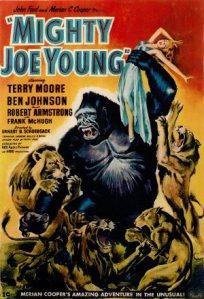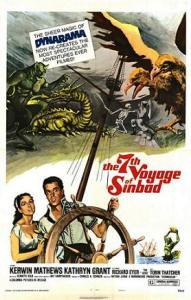As has been widely reported, Hollywood stop-motion model animation guru Ray Harryhausen died yesterday at the age of 92.
Eventually, we as a film viewing public figure out how the magicians are doing their tricks. For example, whereas once we believed a man could fly in the original Superman we now see the wires thus explaining Superman’s perfectly still posture while in the air. Now, with unprecedented levels of increased access via endless behind the scenes documentaries to help pad Blu-Ray/DVD special features we no longer have to wait to actually see how the tricks are performed. However, regardless of when we figure it out it is at the moment of initial exposure to the trick when a film can truly whisk us away into another world. This is when the magic happens. Moments such as these create a feedback loop in which kids so fall in love with the magic they devote themselves to becoming filmmakers and doing it bigger and better thereby passing on the love for film and storytelling to the next generation.
That was Ray Harryhausen. He was but a pre-teen when the original King Kong came out in 1933, but the stunning model animation of Willis O’Brien in the film had Harryhausen hooked. Through a combination of scale model animation and live action footage featuring real actors, O’Brien and his team of artists were able to convince audiences that a giant gorilla really was fighting dinosaurs or that a giant gorilla really could climb the Empire State Building while carrying a screeching Fay Wray. Harryhausen wanted to do that, too, but better.
In 1947, he landed his first job for a major film as an assistant animator to his idol Willis O’Brien on Mighty Joe Young (1949). The film, appropriately enough, was about a giant gorilla.

RKO Pictures presented the Best Visual Effects Oscar the film won to O’Brien, but Harryhausen did most of the actual animation
Harryhausen would begin his career as a solo director of special effects on The Beast from 20,000 Fathoms (1953), and was already improving upon the efforts of the pioneering O’Brien. He was able to more seamlessly combine live action and miniature model animation. He would continue to perfect the craft in It Came From Beneath the Sea (1955), Earth vs. the Flying Saucers (1956), and 20 Million Miles to Earth (1957) before achieving his greatest success with The 7th Voyage of Sinbad (1958).

At this point, Harryhausen’s stop-motion animation became known as “dynamation,” which was a merchandizing term coined by his producer/partner Charles H. Schneer. Ray’s method created the illusion of a model directly interacting with the actors, far more so than anything previously achieved by O’Brien. According to rayharryhausen.com, this is something Ray envisioned as far back as 1939. The exact technical method by which the effect was achieved, involving the projection of live action on a rear screen in front of a model with a glass sheet placed between both, is explained in detail here. Below is one of the iconic scenes from Sinbad:
After The Three Worlds of Gulliver (1960) and Mysterious Island (1961) came arguably Harryhausen’s crowning achievement: Jason and the Argonauts (1963). The standout sequence of the entire film involves seven skeletons coming to life and attacking our heroes (not one, not two, not three…but seven skeletons!)
Such a level of implied interaction behind live actors and stop-motion model elements was stunning to audiences at the time, including now household names like Steven Spielberg, George Lucas, Tim Burton, and Sam Raimi. Harryhausen would continue producing original content in the 1980s, working on such iconic films as One Million Years B.C. (1967; although he really can’t be credited for the splendor of Raquel Welch in a bikini) and two Sinbad sequels (1974’s The Golden Voyage of Sinbad and 1977’s Sinbad and the Eye of the Tiger) before concluding with the original Clash of the Titans (1981). It was only fitting that he was assisted with the animation on Clash of the Titans, his last film, by Jim Danforth, an animator 20 years his junior who had also been inspired by the work done by O’Brien on King Kong.
However, by the time of Jason & The Argonauts Harryhausen had already secured his legacy as he had inspired countless future big name directors as well as big name visual effects artists (well, big names in their field at least) to figure out new ways to give audiences ingenious new magic tricks. For example, many of the artists and techniques used at Industrial Light & Magic (I.L.M.) for the making of the original Star Wars trilogy were directly inspired by Harryhausen. The same goes for Steven Spielberg. In a time when J.J. Abrams can make an unabashed tribute to the works of Steven Spielberg in the form of Super 8 (2011), it is sometimes easy to lose track of who exactly inspired someone like Spielberg in the first place. Harryhausen is one such source of inspiration, noted by Spielberg himself in a statement release to TIME after the news of Harryhausen’s death:
“My early exposure to all the leviathans of the Saturday matinee creature features inspired me, when I grew up, to make Jurassic Park. And the artist magician who breathed life into clay figures and wire armatures and made us, as kids, happily fear for our lives, was the dean of special effects, Ray Harryhausen. All those so called “B movies” were the A movies of my childhood. He inspired generations.” – Steven Spielberg, Time.com
Spielberg is far from alone. Since the news of Harryhausen’s death broke, visual effects giants like Dennis Muren (creative director if ILM), Joe Letteri (senior VFX supervisor at Weta digital), Scott Ross (former GM of ILM), Jeff Okun (chair of the Visual Effects Society), and Eric Roth (executive director of the Visual Effects Society) have all expressed their sympathies and paid their tribute. The same goes for directors Brad Bird and J.J. Abrams. A sampling of statements is featured below:
“For those of us who admired Ray or knew him personally, it is a sad, sad day, one that we hoped would never come. We lost a remarkable man, a lone wolf, a brilliant artist and a mentor for three generations of filmmakers. He is a big reason we are all here and although he will be missed dearly his work will continue to inspire generations to come.” – Dennis Muren (creative director of I.L.M.), HollywoodReporter.com
“Thank you, Ray Harryhausen, for entertaining and inspiring me and so many others. We were mesmerized by the soulful monsters you brought to life and the fantasy worlds you created. Today, it takes an army of CG artists to impress a movie audience in the same way but they’ll never match the humanity and soul you put in your work.” –Henry Selick (Coraline, The Nightmare Before Christmas), HollywoodReporter.com
“There will never be another person who has influenced so many in the art of fantasy storytelling. Ray was, is, and always wil be the master. I had the great pleasure to spend quite some time with Ray, and it is with the deepest respect that I tell the following story. Early on when VES was just getting going, we had our first festival of visual effects headlined by Dennis Muren and the new Star Wars feature. When Dennis began speaking, he introduced Ray Harryhausen in the audience. The crowd went absolutely nuts with cheering and a standing ovation. Since I had just met Ray, I asked him if this huge response was due to the fact that this was a visual effects crowd at a VES event, or did this happen everywhere? Without missing a beat—yet with all the grace and humility that was Ray—he answered softly: ‘everywhere.’ ”–Tom Atkin (founder of the Visual Effects Society), HollywoodReporter.com
“He was, obviously, a genius, infinitely ahead of his time. He inspired us all with his skill and imagination, and will be missed.” — J.J. Abrams (Star Trek, Super 8, Mission Impossible 3), TIME.com
So, when we look back at Harryhausen’s films we might now see the wires, as it were. We are far more aware of the artifice than audiences of the time were. It is now in the realm of CGI that the seamless combination of live-action and animation largely occurs, with many of similar principles in place but the need for 100% motion animation of scale models replaced by the efficiency of a high-powered computer. As a result, the Harryhausen magic may have faded, but it is magic nonetheless. Without it, who knows if we would have ever had Star Wars or any of the formative blockbusters during the special effects outbreak of the late 1970s and entire 1980s or the Lord of the Rings trilogy of the past decade, with both director Peter Jackson and members of the visual effects crew at Weta euphoric in their praise of Harryhausen.
And, for the record, when I showed my 5-year-old nephew the skeleton sword fight scene from Jason & The Argonauts while writing this article he saw no artifice but instead a captivating action sequence, pestering me with questions about how in the world skeletons were walking and fighting. So, perhaps the magic hasn’t really faded at all.
What do you think? Let us know in the comments.

